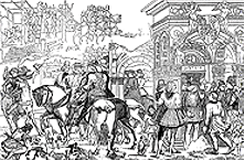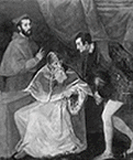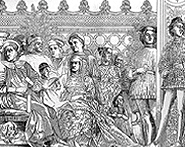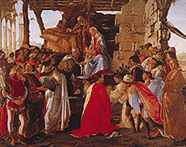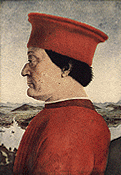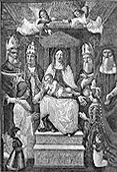Introduction to the Patron Families
IMPORTANCE OF PRIVATE PATRONS
Overview
The wealth in Renaissance Italy created by commercial activities like manufacturing, trade, and banking funded much new construction and decoration. The commissions made by the new upper class of wealthy businessmen affected both the styles of new buildings and the success of individual architects.
Influence on Selection of Styles
By selecting architects whose work was innovative and by approving their designs, patrons affected the transformation of architecture from a medieval style to a Renaissance style.
Patrons who were newly rich and did not have aristocratic origins sometimes adopted the styles used by earlier aristocrats in order to imply that their ancestors had been aristocrats.
The traditional courtly International Gothic style of painting, which dated to the late-fourteenth century, was popular in the early 15th century and continued in use into the mid 15th century.
Similarly, traditionalism continued to be expressed in 15th-century architecture by some patrons. Anachronistic medieval features such as crenellations were still built or were left in place during remodeling.
On the other hand, Florence's leadership in the introduction of the new classically inspired style was furthered by perceptive patrons such as the Medici family, who patronized Brunelleschi, Michelozzo, and Giuliano da Sangallo.
Similarly, the line of architectural development springing from Alberti was bolstered by the construction of buildings he designed for the Rucellai of Florence, the Malatesta of Rimini, and the Gonzaga of Mantua.
Influence on Architects' Careers
Through their commissions, patrons affected which architects and artists were successful.
In some cases, patrons did more than provide commissions. The career of Andrea Palladio, who was originally a stonemason, received a boost from his patron Giangiorgio Trissino, who gave him a humanist education, took him to Rome where he could study important architecture from both the past and present, and introduced him to other influential patrons in Vicenza, where he designed many buildings.
GOVERNMENT FORM AND PATRONAGE
Wealth from Commerce
During the Renaissance, Italy was made up of a number of separate city-states, known as comuni. In these city-states, much wealth was in the hands of the commercial class, who commissioned such projects as private chapels, private palaces, and villas.
Patronage in the individual city-states was affected by whether the government was a republic or an autocracy.
Republics
Republics are political bodies that are governed by bodies of representatives who are elected by the people.
The theoretical political equality between citizens affected architectural styles by inhibiting ostentation. In the 15th century, powerful patrons were aware of the political wisdom of not advertising their wealth.
This is illustrated by an account from Vasari's Lives in which Cosimo de' Medici rejected Brunelleschi's design for an ostentatious new palace and chose a less grand design by Michelozzo because he did not wish to inspire envy.
Autocracies
In regions ruled by single individuals (autocrats), there were more large projects like piazzas and government palaces.
Autocratic rulers financed their projects with revenue raised from taxes, which enabled them to undertake larger, grander projects. Autocratic rulers were more likely than the citizen councils of republics to appropriate private property for other projects.
The employment of court artists and architects had benefits for the arts. Because court artists and architects did not have to worry about obtaining commissions, they were freer to experiment so long as they pleased their patrons. Leonardo da Vinci developed his sfumato technique and investigated many forms of natural phenomena while working for Ludovico Maria Sforza in Milan. Giulio Romano's rule-breaking inventions at the Palazzo del Tè in Mantua would not have been possible without the support of his patron, Ludovico Gonzaga.
Titles of Rulers
Rulers, who inherited power or took it by force, often held the rank of duke or marchese (marquis). Although precedence and inheritance laws were generally followed, ultimate authority in granting titles or re-assigning them when there was no male heir resided with the emperor in the territory of the Holy Roman Empire and with the pope in the Papal States.
Financial incentives often induced emperors to grant titles. Giangaleazzo Visconti, for instance, purchased the title of duke from Emperor Wenceslas in 1395.
●Duke. A duke, which is the highest rank below prince, a king's son, is the ruler of a duchy, which is a small state. A large state is a grand duchy, and its ruler, a grand duke. A duke's wife is a duchess. In Italian, the title is duca except in Venice, where local dialect uses the word doge for its leader, who is elected by a citizenry of aristocrats.
●Marchese. A marchese is the ruler of a marquisate. The marchese's wife or widow is a marchesa. A marchese ranks below a duke and above a count. The rank of marchese was awarded by the emperor of the Holy Roman Empire in regions under his control and by the pope in the Papal States.
Order of Succession
The standard order of succession calls for the oldest male to inherit the title and the estate.
When there is no male heir, the succession passes to the son of a daughter, which would result in a new family name. This occurred in Urbino when rule passed from the Montefeltro family to the della Rovere family with the accession of Francesco Maria della Rovere, who was a grandson of Federico II da Montefeltro through a daughter.
POLITICS AND THE FAMILY
Delegation of Authority to Family Members
Rulers generally filled important positions with members of their family because minimizing the delegation of authority to persons outside the family decreased a family's risk of being overthrown. Dependence on professional administrators and condottieri had been a weakness of the Sforza family's governance of Milan.
The political behavior that favored the preservation of power was the subject of The Prince, a book by Niccolò Machiavelli that includes much information about the rulers of Italy during the late fifteenth and early sixteenth centuries.
Marriages among Ruling Families
Intermarriage among ruling families was a common practice. Financial arrangements often played a significant role in the selection of a spouse. When Emperor Maximilian I married Bianca Maria Sforza, for instance, he received a very large dowry from her uncle Ludovico Sforza.
Because death as a result of childbirth was all too common, many men were married several times.
Problems with Forming Blood Ties
The formation of blood ties between powerful families through their children had both advantages and disadvantages.
●Matrimonial alliances. Families formed alliances through marriage. The political use of marital connections is illustrated by the 1536 marriage of Charles V's fourteen-year-old illegitimate daughter, Margaret of Parma, to Pope Clement VII's illegitimate son, Alessandro de' Medici. The marriage was part of an arrangement between the pope, who headed the Medici family, and the emperor, who used his army to restore the Medici family to power in Florence in 1530. Had children resulted from this marriage, the progeny of both the pope and the emperor would have ruled Florence.
●Rival claims to inherit. Ties to other families could result in conflicting claims when there was no clear successor. For example, a marriage in 1360 between Giangaleazo Visconti of Milan and a princess of the royal family of France formed the basis of Louis XII's claim to Milan in 1499, over half a century after the death of the last Visconti male. Duke Ludovico Sforza, a son of Bianca Maria Visconti, an illegitimate daughter of the last Visconti ruler, resisted the claims of his French cousin, and in the end, he died in a French prison.
Advantages of Large Families
All categories of children had benefits for the family as a whole.
●Sons. Sons were important as heirs to titles and as members of a network of family members who held high political or ecclesiastical rank. Eldest sons were frequently named for paternal grandfathers.
●Daughters. Daughters were important as a means of forging connections with other powerful families through the bonds of marriage.
●Illegitimate sons. Men frequently had illegitimate children with mistresses, whom they sometimes married if their wives died. Legitimate sons had precedence over older illegitimate brothers. When there were no legitimate sons, illegitimate sons often took their place. The list of powerful men of illegitimate birth includes such names as Federico II da Montefeltro, Cesare Borgia, and Giulio de' Medici (Pope Clement VII).
●Illegitimate daughters. Illegitimate daughters of the powerful were also eligible for marriage to important men. Lucretia Borgia, Pope Alexander VI's daughter, was married to Alfonso d'Este, the Duke of Ferrara. Margaret of Parma, an illegitimate daughter of Charles V, was married to the Duke of Florence, Alessandro de' Medici, who was Clement VII's son. (After Alessandro's assassination, Margaret married Ottavio Farnese, the grandson of Paul III.)
ADVANCEMENT THROUGH CHURCH
Family Members in the Church
In wealthy families, younger sons, who were unlikely to become heirs, often entered the Roman Catholic Church. Service at the upper level could be very lucrative and offer many advantages because of the Church's importance during the Renaissance. The decision to enter the Church was usually a practical career decision made by the family during a boy's youth rather than a spiritual commitment by the entrant.
The premature death of an heir usually led to a younger brother renouncing his vows so that he could take his brother's place. Both Cesare Borgia and Ferdinando de' Medici resigned their cardinalates after older brothers died.
Because having ties to high-ranking church officials held advantages for the whole family, fathers endeavored to get sons named to high church offices like archbishop and cardinal. Having a family member occupying the office of pope could catapult a family to a higher echelon of wealth and importance.
Nepotism and the Papacy
The commonness of popes awarding the cardinalate to nephews is demonstrated by the evolution of the term for nephew, nipote, into "nepotism," the conferment of unfair advantages and preferences on the basis of kinship rather than ability. Nepotism was a standard and accepted practice in the Renaissance, particularly within the papacy.
Until the eighteenth century, "Cardinal Nephew," referring to a nephew of the reigning pope, was in essence, an official position. Cardinal Nephews often functioned as seconds-in-command.
In addition to granting cardinalates to relatives, Renaissance popes often loaded them with other offices that carried large incomes. Church appointments carrying incomes are called "benefices."
Because popes had authority over the Papal States as well as the Church, they could appoint relatives to important civic positions.
Families Benefited by the Papacy
During the Renaissance, five families were able to gain election to the papacy a second time. The first was the Barbo family (Pope Eugene IV and Paul II) of Venice, the second was the Borgia family (Callistus III and Alexander VI) of Spain, and the third was the Piccolomini family (Pius II and Pius III) of Siena.
The fourth family to be elected pope twice is the della Rovere family, which rose to prominence after the election of Francesco della Rovere. As Pope Sixtus IV, he appointed several nephews to be cardinals, and because one of them became Pope Julius II, another wave of nephew appointments took place in the next generation.
The Medici family is the fifth family that was elected to the papacy twice in the Renaissance. The first Medici pope, Leo X, awarded the ecclesiastic posts of Archbishop of Florence, cardinal, and Vice-Chancellor to his cousin Giulio de' Medici, who became Clement VII. Because Clement VII held the power of the papacy, he was later in a position to make a deal with Charles V that restored the Medici family to power in Florence after they had lost control in the wake of the Sack of Rome.
Although Cardinal Alessandro Farnese, the eldest grandson of Pope Paul III, was not elected pope, he was enriched by so many high-paying posts in the Church that he was one of the richest men in Italy. In addition to completing a palace and a villa of exceptional size and grandeur, the cardinal sponsored most of the cost of building one of Rome's finest churches, Il Gesu.
WRITTEN REFERENCES TO PATRONS
Biographies
Laudatory biographies of important family members were sometimes commissioned by their successors. These works could create an impression of noble lineage or legitimate succession.
Concern with the legitimacy of his claim to power probably motivated Ludovico Sforza to commission Giovanni Simonetta to write a biography of his father, Francesco Sforza.
Histories of Cities
Because contemporary historical accounts of cities contained information that affected the reputations of important families, rulers sometimes engaged humanists to write historical accounts. Naturally, these portrayed the patron's family in a favorable light.
Ludovico Sforza commissioned Bernardino Corio to write a history of Milan and made the state archives available to him. Because Ludovico was imprisoned in France at the time of its publication in 1503, he did not get to enjoy the prestige that its publication would have brought.
Giulio de' Medici commissioned Niccolo Machiavelli to write History of Florence (1520-25), which emphasized the role of the Medici in the city's development.
Vasari's Lives of the Artists
Vasari's Lives, which was supported indirectly by commissions from the Medici family for the author's services as a painter and an architect, stressed their good judgment and attentiveness in the selection and design of works they commissioned.
PROCLAMATIONS OF OWNERSHIP
Coats of Arms
A coat of arms is a grouping of specific images that are placed in a certain order on a shield-shaped device.
Coats of arms were useful in identifying an individual family through symbols rather than print, which was important in the Renaissance due to the illiteracy of many.
The presence of a coat of arms on a work usually indicates that a particular family commissioned it. Coats of arms signified ownership and could be added or removed as ownership changed.
Because the use of heraldic emblems dated to the Middle Ages, a family's having one implied aristocratic lineage.
Placement of Coats of Arms
Coats of arms were used in a variety of places including in books and paintings. In churches, they identified the patron families of individual chapels. On the façades of palaces, coats of arms were sometimes placed over doors or windows at the center of the façade or on corners. In courtyards, they decorated ressauts and friezes. Inside palaces, coats of arms were commonly incorporated into the decoration of ceilings, walls, and doors.
Selection of Images
Coats of arms were distinguished from each other by the particular images they displayed.
The particular images chosen to represent families often included attributes related to the family name. A pair of testicles adorned the coat of arms of the Colleoni family, whose name is derived from coglioni, the Italian word for "testicles." (The Colleoni family, who were one of the leading families of Bergamo, are best remembered in art history as the patrons of Verrocchio's equestrian portrait of the condottiere Bartolomeo Colleoni, which stands in Venice, and of Amadeo's Colleoni Chapel at Bergamo Cathedral.)
The selection of images on coats of arms was sometimes modified to reflect changing circumstances. The Farnese family added the fleur d'lis, an emblem of the French royal family, to their coat of arms after the marriage of Orazio to Diane of Valois, illegitimate daughter of the French king Henry II.
Images Used Separately
Individual parts from coats of arms like a particular kind of foliage or animal were often used independently of the family emblem on moldings and other architectural members. This is illustrated by the oak leaves associated with the della Rovere family because the name "rovere" means "oak." Oak imagery was often incorporated into paintings and architectural ornaments commissioned by members of the della Rovere family.
Astrological signs were also used to signify patronage. Duke Cosimo I de' Medici utilized his own astrological sign, the Capricorn, to identify his patronage.
Inscriptions
Another form often used to identify patrons was the inscription, which had the advantage over pictorial images of being able to announce details concerning the commission such as dates or the patron's achievements.
Inscriptions were most often placed on the friezes of façades and courtyards and on the moldings of windows and doors. Inscriptions were also incorporated into decorative features like stuccoed ceilings and painted walls.
ARCHITECTURAL COMMISSIONS
Palaces and Villas
The architectural forms that most distinctly reflected an individual family's wealth and taste were palaces and villas.
Collections of art, ancient coins, old manuscripts, and valuable natural objects such as gemstones fostered the creation of a special type of room, the studiolo, which was planned to house the owner's most prized objects.
Because palazzi and villas served as the family's private domain, patrons often selected worldly themes like mythology for their decoration. It is significant that Donatello's David, which was the first classically conceived freestanding male nude sculpture made since antiquity, was sculpted for a private villa.
Churches and Chapels
Because only rulers and the wealthiest of families could afford to sponsor the construction of whole churches, most wealthy families limited themselves to the decoration or renovation of chapels within or adjacent to churches. These spaces ranged from bay-deep compartments along the sides to large sacristies and chapter houses.
New churches like Santa Maria del Popolo were partially financed by the wealthy patrons who each received exclusive patronage rights to one of the chapels that lined its sides. These spaces, which generally contained the tombs of the patron and other important family members, functioned as chapels for private services.
Church furnishings such as carved altarpieces, choir stalls, pulpits, and tabernacles were also commissioned by private donors.
Relative Costs of Decorative Materials
The materials used in the decoration of palaces, chapels, and other areas associated with the individual families varied considerably in cost. Fresco was the cheapest form of wall decoration, and tapestry and encrusted polychrome marble were the most expensive.
WAYS PATRONS WERE PORTRAYED
Painting
Painted portraits took a number of forms, and these became increasingly self-aggrandizing as time passed and a family's importance increased.
●Subjects of individual portraits. Paintings of individuals were the most common form of portrait in the Renaissance. In the fifteenth century, portraits were often in profile and showed the subject's head and shoulders or head and chest. Antonello da Messina introduced the use of a foreground ledge. In the sixteenth century, coverage increased to include the upper body and hands. Full-length portrayals announced persons of great distinction. Furs and fine fabrics were worn by both men and women of high station. Women were shown wearing necklaces, hair ornaments, and dresses sewn with pearls and jewels; often these objects were associated with marriage and the idea of female virtue. Children were sometimes included, especially if the adult was a woman. Backgrounds depicting land announced the possession of territory. Objects and documents were increasingly used to particularize the subject's interests, achievements, and character. Depiction in armor, which signified the sitter's role as a defender of the community, suggested military achievement, especially if shown on horseback.
=Participants in courtly activities. Patrons were depicted performing acts from their own lives such as receiving visitors, commissioning important projects, and taking part in leisure activities such as hunting.
=Tomb effigies. Painted versions of equestrian statues were sometimes used to mark the tombs of condottieri .
=Donors in religious paintings. Depictions of patrons as solemn, prayerful witnesses were included in scenes like the sacra conversazione, and the Trinity. At the dawn of the Renaissance, donor figures were distinct from holy figures in being smaller in scale or located outside the space occupied by the holy figures, but as time passed, donor figures were increasingly placed within the same space. By the sixteenth century, donors figured into religious paintings thematically as well as physically.
=People in scenes. The facial features of donors or important people were often used for figures in scenes or gatherings illustrating historical, religious, or philosophical themes.
Sculpture
Busts were the most common form of sculpted portrait.
●Busts. Like ancient Roman portrait busts, in the Renaissance portrait busts were typically about life size and naturalistic in varying degrees. Busts were commonly modeled in terracotta or carved in marble. They were also cast in bronze, but this form was far more expensive. Among the most admired sculptors of portrait busts were Antonio Rossellino, Desiderio da Settignano, and Verrocchio, who all worked in Florence in the second half of the fifteenth century.
●Commanders on horseback. Like ancient Roman emperors, Renaissance rulers and military commanders were sometimes represented by freestanding, life size or larger, bronze portraits on horseback, which were placed in public squares. Bronze equestrian portraits were first used in the Renaissance for monuments to condottieri like Donatello's Gattamelata and Verrocchio's Colleoni. Ludovico Sforza asked Leonardo da Vinci to design a colossal equestrian portrait of his father, Francesco Sforza, who had been a successful condottiere; although the model was made, the monument was not cast because Ludovico needed the bronze for weaponry against the French. Later, Leonardo worked on designs for an equestrian sculpture representing the Milanese condottiere Trivulzio, but again, no monument was cast.
●Mythic or historic heroes. The facial features of patrons were sometimes applied to the bodies of heroic figures. The features of Neptune in Ammannati's Neptune Fountain in the Piazza della Signoria are those of its patron, Cosimo I.
●Tomb effigies. Sculpted effigies of the deceased most often took the form of recumbent figures on the sarcophagi of wall tombs and slab tombs. Seated images, which were less common at the beginning of the Renaissance, became standard for papal tombs by the 17th century.
WOMEN AS ARCHITECTURAL PATRONS
Women Commissioning Architecture
Women's ability to commission architecture was in large part determined by their social status and location. Extremely wealthy women in a court setting such as Mantua or Parma had a relatively high level of autonomy and thus the ability to privately fund architectural projects. Isabella d'Este, who was exceptional for her wealth, influence, and autonomy, was one of the best-known women patrons in the Renaissance. Her ability to commission architectural projects like her famous grotto was also exceptional.
She built two studioli and grottos in the Ducal Palace in Mantua for the two apartments she occupied sequentially in her roles as Marchesa of Mantua and then as the mother of the new Marchese of Mantua, her son Federico II. She commissioned paintings from Mantegna, Perugino, and Lorenzo Costa for her first studiolo and paintings from Correggio for her second. The grotto below the studioli held her collection of antiquities, including coins, gems, medals, and some contemporary sculpture in the ancient manner.
Deterrents to Women's Commissions
A number of factors hampered women's ability to commission architecture.
●Lack of money. The first and foremost impediment to women building was the cost. Of all the arts, architecture was, and still is, the most expensive.
●Lack of legal rights. In some parts of Italy, Milan for example, women were restricted from inheriting property in their own name. By Italian law, women could not make contracts or administer property. When dealing with the legal aspects of property ownership, women were constrained to utilize an intermediary known as a mundualdus, a man who would execute legal decisions on a woman's behalf.
●Lack of autonomy. In general, women were under the control of their fathers or other male relatives until they were married, and then, they were under the control of their husbands.
●Lack of personal freedom. Women lived relatively isolated lives in which they were confined to their family palazzi and only free to go out if going to church. The public nature of architectural patronage is at odds with this sequestered life style.
Situations Giving Women Autonomy
Women's autonomy varied according to their situations.
●Membership in convent. Being members of convents gave women in authority the funds and voice of many, which enabled them to commission architecture. Once in the convent, a woman would have more control over her dowry than she would have in a marriage. Smaller sums were often pooled to undertake collective projects. The special legal status of women in religious institutions in combination with their continuing connections to their own noble and aristocratic families gave some members considerable financial and political power.
●Widowhood. Widowed women in Renaissance Italy had a number of options following their husbands' death. Their ability to determine their futures depended in large part on their relationships with their marital and natal families and their access to their dowry money.
Widows with Access to their Dowries
In the Renaissance, the dowry was a sum provided by a woman's family, usually at the time of marriage, which was intended to provide for her support. In theory, and by law, the dowry remained the widow's legal property and was to provide for her financially.
A widow could remain in her husband’s household or move to the household of a male relative from her natal family, such as her father or a brother. Freed from the direct control of a father or husband, and without domestic obligations, widows had more freedom to do what they wished with their money. Along with nuns and noblewomen, widows were among the most powerful female patrons in early modern Italy.
Widows without Access to their Dowries
In practice, it was often difficult for women to regain control over their dowry funds, and the money could incite legal battles among the widow, her marital family, and her natal family. Without access to her dowry, a widow's future was largely determined by her relatives.
●Remarriage. Young widows were often remarried as quickly as possible, in order to ease the financial burden they imposed on their paternal and marital families and to increase social networks.
●Entrance into a convent. If older when widowed, and therefore past an attractive age for a bride, the primary option was a convent. Depending on the institution, conventual life could provide a venue in which a group of women were permitted more control over their daily affairs than in the secular world. Many women chose the convent over remarriage. Although legally their dowry went to the convent and became part of the communal funds, often women could still exert some control over the use of their funds. In addition, women could and did establish their own religious institutions or houses for women to live a spiritual life in a communal setting.
WHAT WOMEN COMMISSIONED
Social-Welfare Aspect of Commissions
Women generally commissioned architecture that was related to religious or social-welfare institutions, and this raises the issue of whether this circumscribed field represents the internalization of societal norms, or whether it is a case of making the most out of what options were available to them.
Put another way, would women have preferred building palaces and villas but settled for building chapels and convents because they believed that it was only appropriate for them to build the latter? Or were women responding to the restraints and challenges of their situations and building in order to improve their larger lot?
The list of convents, shelters, and houses for poor girls and fallen women could also suggest that women constructed out of a desire, often based in ideals of Christian piety, to help other women, from daughters to strangers.
Family Chapels
♦Capella Pellegrini, Verona. Margarita Pellegrini (1529-57) commissioned Sanmicheli to design an elaborate chapel, the Capella Pellegrini, in the church of S. Bernardino in Verona. The chapel was intended to house her tomb, along with those of her daughter and son.
♦Chapel of San Lorenzo, Rome. In Rome, Camilla Peretti, the sister of Pope Sixtus V, commissioned the chapel of San Lorenzo in the church of Santa Susanna from architect Domenico Fontana. The chapel, which was finished by 1591, features wall frescoes depicting lives of the Early Christian saints Eleutherius and Genesius.
Convents and Churches
Women could found and build religious institutions such as churches and convents. In addition to constructing convents, their female founders also provided for their decoration and furnishing.
♦Convent of San Paolo, Milan. In Milan in 1535, the widow Ludovica Torelli, Countess of Guastalla, founded the convent of San Paolo. Torelli was able to build a convent for one hundred nuns, and constructed a monastic complex including a choir and cloisters.
♦Convent of S. Maria dell'Umiltà, Rome. Francesca Baglioni Orsini founded the Dominican convent of S. Maria dell'Umiltà in Rome and provided clothes and silver vessels for it.
♦Convent of S. Caterina di Siena a Magnanapoli, Rome. In the late 16th century, Portia Massimi built the church and convent of S. Caterina di Siena a Magnanapoli in Rome, which was replaced by another structure in the 17th century.
♦Convent of S. Maria Maddalena, Rome. Maddalena Orsini built the convent of S. Maria Maddalena, which was destroyed 1888.
♦Convent of S. Urbano, Rome. Fulvia Conti Sforza built the convent of S. Urbano, which was destroyed 1933.
♦Church of San Bernardo alle Terme, Rome. At the end of the 16th century, Caterina de' Nobili Sforza built the church of San Bernardo alle Terme to house a radical branch of the Cistercian order. Like the main body of the Pantheon in Rome, the building was cylindrical in plan, vaulted by a dome, lighted by an oculus, and lined on its interior with niches. Statues of saints occupied the niches just as statues of Roman gods had originally occupied the Pantheon's niches.
Social-Welfare Buildings
Often based in ideals of Christian piety, women also founded and built structures intended for social welfare.
♦Casa delle Zitelle, Venice. In mid-16th century Venice, a group of noblewomen founded the Casa delle Zitelle (Home for Unmarried Women) to house and educate young women in need.
♦Shelter of Santa Maria del Rifugio, Rome. In Rome, the marchesa Giulia Orsini Rangone built a similar shelter, known as S. Maria del Rifugio. This shelter was intended to assist three different classes of women--poor unmarried girls, women who had fallen into sin but who wanted to reform themselves, and needy widows. The foundation's mandate was reflected in its structure, which featured three distinct architectural spaces for the three different categories of inhabitants.
Buildings for Jesuit Notiviates
Women also constructed sacred buildings that were not for women such as buildings for Jesuit notiviates.
The first permanent Jesuit notiviate in Rome, S. Andrea al Quirinale, was founded by Giovanna d'Aragona Colonna, who contributed land, part of her house, and an endowment.
Another Jesuit novitiate, which was dedicated to San Vitale in Rome, was founded by Isabella della Rovere.
other patron families
In addition to the 7 patron families covered on the following pages, discussing important patron families, there is also more information about the following families:



 Add Placemark
Add Placemark Go Back
Go Back 





